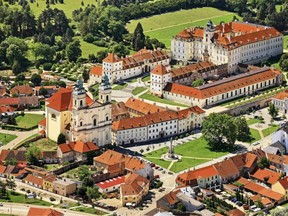From the Valtice castle to a picturesque Hobbit-like village of underground wine cellars

Reviews and recommendations are unbiased and products are independently selected. Postmedia may earn an affiliate commission from purchases made through links on this page.
By Sara Waxman
Liquid treasures of Valtice

Wines registered in the salon must be made exclusively from local grapes and must pass the system of nomination exhibitions. One hundred wines are given the rights for their bottles to be signed with the Gold Medal of the Wine Salon of the Czech Republic every year. The wines are then presented to the public in Valtice. Guided by a sommelier, I taste samples of as many wines as I can hold, and still retain my equilibrium well enough to read the fascinating stories about each wine and its producer. After several hours, emerging from the cellars and strolling in the fresh breeze through the manicured gardens, I feel that I’ve had a time-travel experience — one that I may never have again.
Plže: A Hobbit village?

Have I stumbled into a quaint Hobbit Village? Will the Seven Dwarfs emerge from one of these cottages built into the hillside whistling and singing “Hi Ho! Hi Ho! It’s off to work we go?” In the 1700s, these structures were built into the earth as cool places to store wine, and on the hillside we see ventilation chimneys sticking out of the ground almost like tree stumps. A larger-than-life ancient wood sculpture of Saint Urbain, the Patron Saint of wine, had been carved at the time from a single tree trunk. The patina of age glows from Saint Urbain as he stands guard, protecting the soul of the wine. Searching for adventure and wine, I knock on a massive green door and am welcomed by the winemaker, who readily offers a tasting. He chooses a bottle from the shelves that line the cottage, and with a wine barrel as a table, he gives a generous pour into an oversized Bohemian glass goblet and tells me about his vineyard high up on the mountain. Na zdravi! I am delighted to purchase a Pinot Blanc, and three weeks later, at a small dinner at my home, I pour the wine and share the story. Is this not one of the joys of travel?
Gurdau Winery: The roots of the vine

The golden era, history shows, was in the 18th century, when the winery had 400 hectares. Alas, all destroyed by the ravages of the First and Second World War. Still, in 2010, the microclimate beckoned a savvy entrepreneur who began to revive the winemaking tradition. In the valley there is a constant funnel like wind, and it cools down the vines. Little rain, hot and dry in summer, and the focus is on the plants, to get the roots down as deep as possible. Today, those roots grow 20 to 25 meters down. Not until 2016 did they produce the first batch of wine, and from there the production grew to 35,000. This evening, the family-owned business will celebrate the fruits of their sustainable practices and meticulous techniques and, I’m told, with justifiable pride, “We’re going to be opening Bordeaux wines from the vintage 2003.”
The spiritual centre of Mikulov

There are at least thirty vineyards around this town of 7,000 people. Riesling, Chardonnay, Grüner Veltliner and many of our most appreciated varieties grow in the Mikulovská Wine sub-region, on and around the Pálava limestone cliff.
Organic to the bone
Vino Cibulka ensures there is nothing in the wine that does not belong there. The production has been totally organic since the beginning. Herbs grow in their two vineyards, bees and butterflies fly around and the meadow is abloom with flowers. The Chardonnay and the Champagne produced are crisp and refreshing, and reflect the terroir around us.